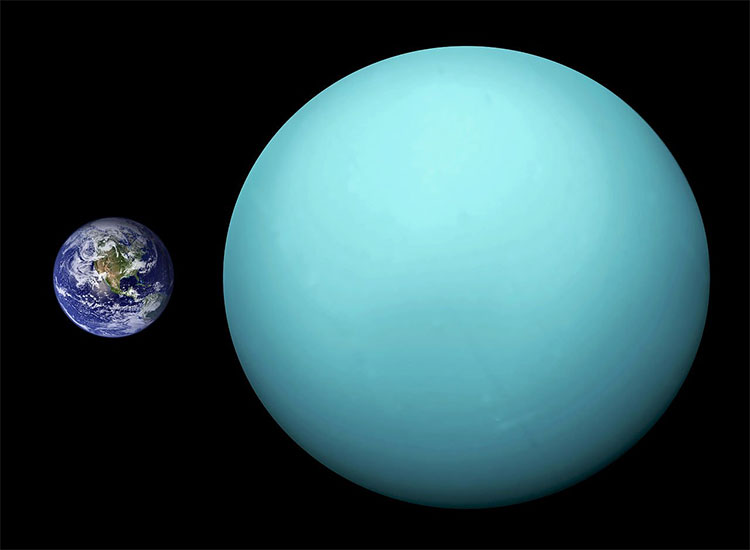Overview of Uranus
Uranus is the seventh planet from the Sun; is the third largest and fourth largest planet in the system.
Uranus has a composition similar to Neptune, and both have different chemical composition than the two larger giant planets, Jupiter and Saturn. For this reason, astronomers occasionally divide them into other planets called "giant ice planets".
The structure of Uranus
The mass of Uranus is almost 14.5 times larger than that of the Earth, and is the lightest gas planet. Its diameter is slightly larger than the Neptune star about 4 times the diameter of the Earth. Its average density is 1.27 g / cm 3 and is the second smallest medium-sized planet, only larger than Saturn. This value indicates that it has a major component of ice types, such as water, ammonia, and methane.
Uranus's inner heat seems to be lower than other planets; In astronomical terms, it has low heat flux. Astronomers still don't understand why the temperature inside this planet is so low.

Compare the size of Earth and Uranus.
Uranus's atmosphere
Aoi Thien Vuong's atmosphere is similar to that of Jupiter and Saturn on basic components such as hydrogen and helium, but they contain many " volatile compounds" such as water, ammonia, and methane, along with the amount Small hidrocarbon.
Although there is no specific solid surface in Uranus, the covering of external gases that can be monitored remotely is called the atmosphere by scientists.
Uranus's belt
The planetary belt system contains most of the particles that reflect very poor light, with sizes varying from a few microns to a few meters. So far, scientists have counted 13 belts in the system, the brightest ring called the ring ε. Except for the two rims, the rest have very narrow widths - they are usually only a few kilometers wide. Maybe the age of the belt system is quite young; and through their dynamics scientists think that they do not form with the formation of Uranus. The matter in the rings could be a remnant of a satellite (or many satellites) that have been broken after big bumps. From a lot of debris shot after time-based incidents, only a small number of dust particles or small rocks existed in stable orbit and formed into today's belt system.
The climate of Uranus
Observing through ultraviolet and visible wavelengths, the Uranus atmosphere appears to be almost uniform compared to the intense activity in the atmosphere of other giant planets, even as Neptune, an onion. Crystal has many similar structural and composition properties. One explanation for the stillness in the planet's atmosphere is that Uranus's internal heat seems to be much lower than other planets. The ship recorded the lowest temperature in the tropopause of 49 K, and it was the coldest planet in the Solar System, colder than Neptune even though the planet was farther away from the Sun. compared to sao Thien Vuong.
Uranus's natural satellite
Astronomers now know Uranus has 27 natural satellites.
Explore Uranus

Crescent image taken from Voyager 2 when it is flying far from the planet.
In 1986, the Voyager 2 spacecraft flew over the planet Uranus. Up to now, the only ship flying over this planet has a short distance, and there is no plan to send a ship to explore it.
Scientists once proposed a plan to send Cassini to Uranus during a conference on expanding the ship's exploration program in 2009 but eventually the plan was canceled. If sent, the ship will take about 20 years of journey from Saturn to Uranus.
- 'Unbelievable' facts about the Uranus star
- Discovered 'copy' of Uranus
- The first image of Uranus
- Uranus - The most exotic planet in the Solar System
- Discover the green belt around the Uranus
- Special points of Uranus
- Astronomers claim that Uranus smells like ... fart
- Two Uranus moons can crash into each other
- Aurora on Uranus
- Uranium - Radioactive elements
- Simulate diamond rain on Neptune and Thien Vuong
- The position of two spacecraft leaving the Earth 38 years ago
 Van Allen's belt and evidence that the Apollo 11 mission to the Moon was myth
Van Allen's belt and evidence that the Apollo 11 mission to the Moon was myth The levels of civilization in the universe (Kardashev scale)
The levels of civilization in the universe (Kardashev scale) Today Mars, the sun and the Earth are aligned
Today Mars, the sun and the Earth are aligned The Amazon owner announced a secret plan to build a space base for thousands of people
The Amazon owner announced a secret plan to build a space base for thousands of people NASA releases never-before-seen images of Uranus
NASA releases never-before-seen images of Uranus  Could a planet so close to Earth be full of swimming fish?
Could a planet so close to Earth be full of swimming fish?  Scientists have discovered that Uranus is not completely filled with ice
Scientists have discovered that Uranus is not completely filled with ice  James Webb Glasses will restart studies of 'ice giants' in our Solar System
James Webb Glasses will restart studies of 'ice giants' in our Solar System  Why Neptune and Uranus have different colors?
Why Neptune and Uranus have different colors?  Shock: blue planet in Solar System is 'transforming'
Shock: blue planet in Solar System is 'transforming' 